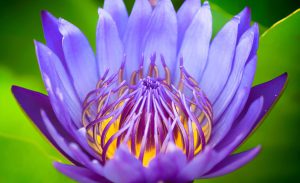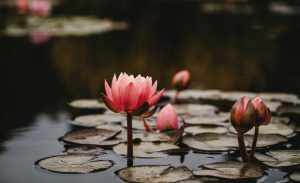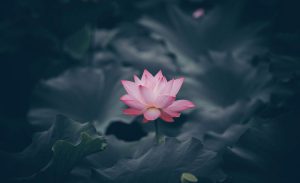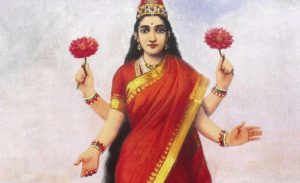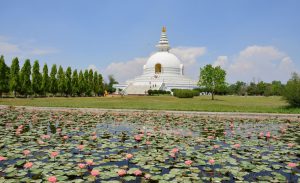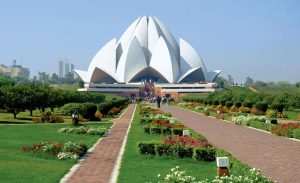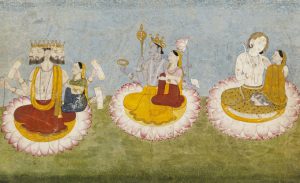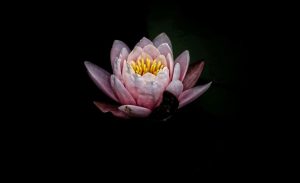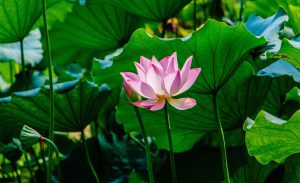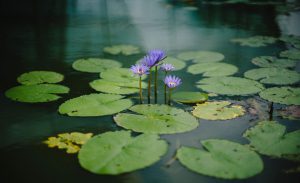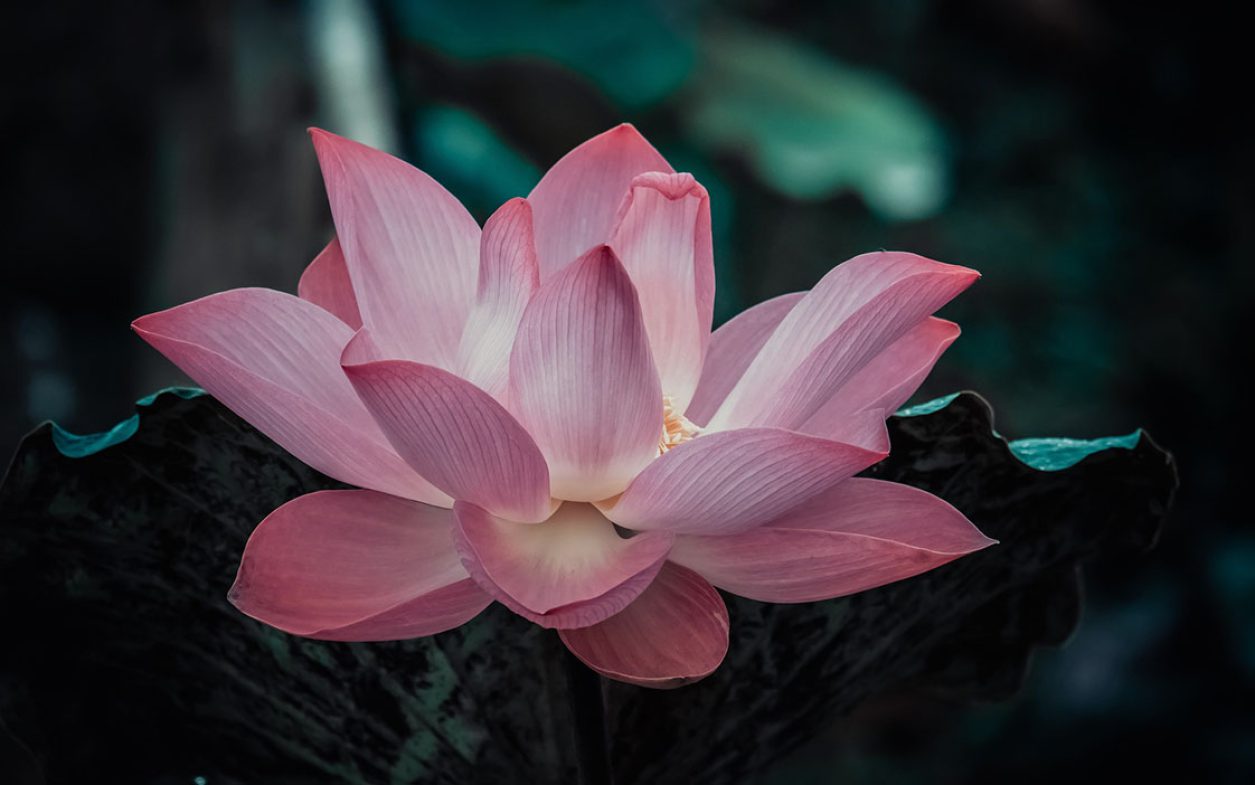
art of travel
Monthly Musing
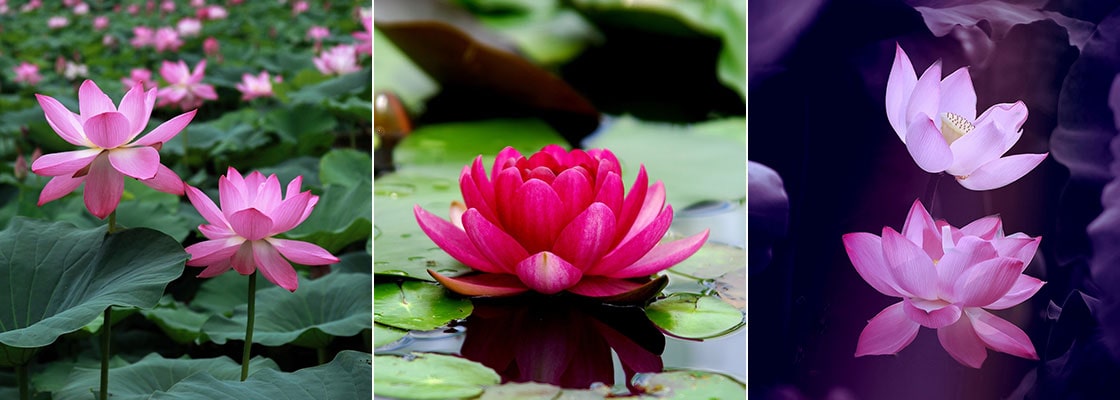
Decoding the Lotus
India will assume the presidency of the powerful G20 group of Nations from the current chair, Indonesia, on December 1, and hold the post for a year. Whilst the G20 presidency offers a unique opportunity for India to contribute to issues of international importance, the good news for the tourism industry is that the G20 member nations account for the highest number of foreign tourist arrivals in India. There are 200 meetings planned at 56 locations – both big and small cities- to showcase India’s cultural heritage and diversity. The recently unveiled G20 logo which draws inspiration from the colours of India’s national flag is orange and green, along with a globe and the earth and a blooming lotus with seven petals reflecting growth amid challenges. The inclusion of the Lotus is really interesting here. From its earliest mention in the Vedas, a collection of hymns, prayers, and rituals, written some 4000 years ago as the flower from which all creation emerges to its current inclusion in the G20 logo; the Lotus has been an alluring and exalted part of India’s culturescape and continues to do so.
The ability of the Lotus to bloom in the murkiest conditions has appealed to humankind for centuries. In the Yoga and Ayurveda tradition of India which has captured the world’s imagination in the realm of wellness, the seven chakras – energy centers in the body that correspond to specific nerve bundles and internal organs – are each symbolised by a Lotus of a specific colour and with a specific number of petals. Recent scientific studies have revealed that the Lotus is packed with properties – vitamins, minerals, and anti-inflammatory agents – that can impact our everyday lives and well-being. Lotus flower extracts are also fast becoming a staple in modern skin care because of the flower’s ability to regenerate.
However, across the world and in India, the Lotus has been associated with much more than its healing and regenerative qualities. It has been a powerful spiritual symbol and a revered flower when it comes to spiritual or religious ceremonies. The most influential Buddhist text which is considered a guide to unleashing the transformative potential of each individual’s life is called the Saddharma Puṇḍarīka Sūtra or the Lotus Sutra. Many Hindu and Buddhist deities are shown seated or standing on a fully open Lotus flower depicting the transcendental, subtle and spiritual body of the deities which is weightless.
The Lotus is also an extremely popular motif in the architecture, art and craft of the Indian subcontinent. India’s two most sacred river goddesses Ganga and Yamuna are always shown holding a long stemmed lotus whose undulations match the contours of their elegantly standing ‘S’-shaped bodies. In Indian miniature paintings that flourished in the royal courts, the water bodies – rivers, lakes, ponds – are always indicated by the Lotus flower and its broad leaves floating on their surfaces. In the Pahari miniature school of painting in the Western Himalayas, all Hindu deities sport pinnacled crowns of lotus buds. Stylised carvings depicting the Lotus have been found in the Ajanta caves (2nd century BC to 7th century AD), and on the Buddhist Stupa in Sanchi (3rd century BC). The Lotus was also incorporated into the Mughal architecture in the subcontinent which can be seen in monuments such as the 15th-century Humayun Tomb. One of the most important motifs used in Kolams – a geometrical line drawing composed of straight lines, curves, and loops, drawn around a grid pattern of dots – drawn during harvest festivals in South India – is the Lotus. And how can we forget the great masterpiece by the local sculptors in the famed 11th century Jain temple at Mount Abu in Rajasthan, who produced an exquisitely carved pendulous, filigree-like Lotus rosette, the central component of its ceiling that will leave you spellbound. The Lotus rosette as a motif can also be seen in woven and printed textiles as well as in stone and wood carvings, and in ornaments worn by women, used with immense innovativeness and imagination all over India.
What’s New

Dileep Kothi, Jaipur, Rajasthan
Dileep Kothi is the family home of the erstwhile Royal family of Barli. The 16th generation of the royal family has lovingly refurbished this private residence to capture the essence of its illustrious past, present, and future. An all-suite stay with six spacious living spaces nestled in the charming neighbourhood of Pink city, the luxury homestay is close to the famous attractions of Jaipur. Each luxurious suite provides the ideal blend between the traditional and the contemporary. On prior request, the family can organise a specially curated private dining experience from their Royal Kitchen exclusively for our guests.
Weaving it into an itinerary:
Routing: Delhi – Agra – Jaipur – Jodhpur – Udaipur – Mumbai

Arth, Lohardaga, Jharkhand
Arth is a secluded hideaway nestled amidst picturesque scenery, varied wildlife, rolling hills, and serene water. This four-suite cottage is lovingly handmade by the natives from natural materials in an inimitable style. Here, guests can savour a range of cuisines, starting from authentic dishes to international food prepared using locally sourced ingredients. And of course, there are exciting activities to choose from, offering something for everyone – be it an adventure, nature, culinary experiences, or hands-on workshops. Visit and surprise yourself!!
Weaving it into an itinerary
Routing: Kolkata – Bawali – Mayurbhanj – Ranchi – Lohardaga – Bodhgaya – Varanasi – Delhi

A Culinary Experience with Sundari, Chennai, Tamil Nadu
India’s iconic signature delicacies have been savoured by presidents and celebrities alike. Now it’s your turn!
Health and taste are generally the opposite poles and it requires a tremendous act, knowledge, and experience to balance the two. Indian food incorporates specific herbs and ingredients that are meant to be part of a holistic way to regain the mind and body’s health and vitality.
Meet Sundari Krishna, a fantastic host who is passionate, friendly, and loves to cook. To Sundari, cooking is a science and provides an opportunity to research every day. Her passion is to study nutrient values and even calorie count for each ingredient and bring out this balance. Her travels, combined with a passion for food made her participate in numerous cooking competitions across the globe. As a foodie, she possesses a vast knowledge of both north and south Indian cuisine. In her cooking, she strives to create the perfect balance between flavour and health.
She and her husband reside in a beautiful house overlooking a garden in Chennai, about one kilometre from the sea, where they welcome visitors to indulge and learn about Indian cuisine. You may choose to have an interaction with her while learning some Indian dishes, relishing a home-cooked meal, or enjoying a delicious high tea.
Where: Chennai
Duration: 2 – 4 hours (depending upon the experience)
Minimum: 01 guest
Maximum: 06 guests
Note:
- Only vegetarian meals would be cooked and served.
- No alcoholic beverages would be served/ allowed
Stories from India
The Story of Black Pepper
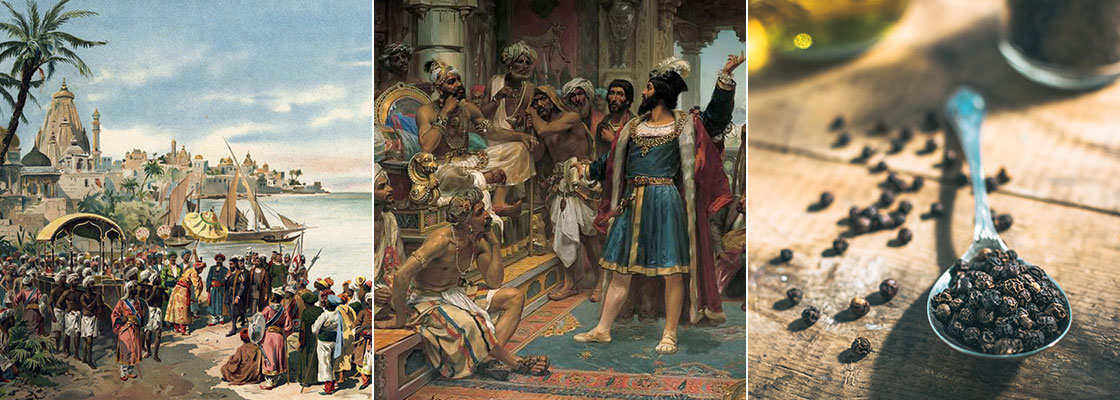
Whist the Camel Caravans on the Silk Route plodded through the Thar Desert in India’s distant Northwest corner braving extreme conditions; in the Southern part of India, the sea traders on the Spice Routes reached Kerala facing treacherous sea voyages looking for black pepper. It was an import so prized and such was its prominence as a luxury commodity that in 410 AD when the Huns lay siege of Rome, 3000 pounds of black pepper was demanded as a ransom. Just like Jaisalmer, Afghanistan, Iran, Egypt and Turkey along the Silk Route, several ports and flourishing trade centres emerged worldwide along the Spice Routes including Muzuris, Cochin, and Kozhikode in Kerala. The Arabs traders of Oman and Yemen were the first to hold sway over the maritime spice trade from Kerala as early as 600 BC and served as intermediaries between India and Europe. They would sail on their dhows (boats) to Basra (in present day Iraq) and Constantinople (present day Istanbul) to sell their spices to the merchants of Venice who amassed a fortune distributing it across Europe. It was the black pepper trade which singlehandedly built the glorious city of Venice. The dhows on which the Arabs sailed are still constructed at Beypore town in Kozhikode in North Kerala in the exact same tradition, now for affluent clients from the Middle East.
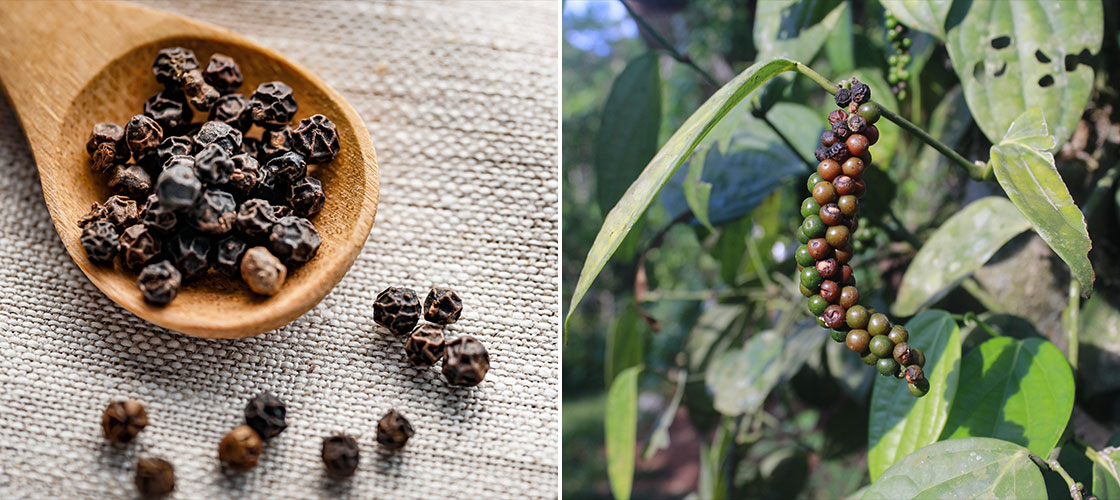
Some of the Arabs traders settled down in Kerala, intermarried with the locals and spawned a unique cultural diffusion that lasts till date. The Chinese came thereafter and traded with Kerala in between the 12th and the 15th centuries. Not too many know that the 7 feet tall Admiral Zheng Hee of the Imperial Ming Navy landed in Kozhikode in the year 1408, almost 100 years before the Portuguese Explorer Vasco-Da-Gama did. The fleet of Admiral Zheng, it is said, was like a floating city with 60 ships and 20,000 men, something the world has never seen before. Historians believe that the Chinese Fishing nets were introduced to Kerala by Admiral Zheng. Malayalam (the local language of Kerala) words for, such as a wok, a pickle jar and silk are all prefixed with the word Cheena (or China). The striking similarities of architecture between the 15th-century Temple of Heaven in Beijing and the Madhur Temple of Kasargod in North Kerala are equally mindboggling.
Vasco-Da-Gama’s arrival in Kozhikode, a momentous event which changed the course of maritime history, opened the flood gates for the seafarers of the world and ended the Arab-Venetian monopoly over the Spice trade. The Dutch followed the Portuguese and then came the British. They all vied for control of the lucrative trade with coercion and conciliation alike. The 16th century Matancherry Palace or Dutch Palace in Cochin was built by the Portuguese with stunning murals of Hindu deities and a temple inside its premises as a gift for the King of Cochin. The Dutch later renovated it. During the same time, a similar diplomatic manoeuvre by the Portuguese and later by the Dutch was recorded in the trading post of Nagasaki in Japan for its Daimyō (feudal lord).
Along with the seafarers, the spice trade also brought enterprising communities from the rest of India to Kerala. Just like the King of Jaipur in Rajasthan, the King of Cochin invited these highly skilled communities from across India to settle down in Fort Cochin to trade and flourish. This resulted in a fascinating socio-cultural exchange, the traces of which can be still seen in Fort Cochin’s diverse communities, neighbourhoods, alleys, cuisine, festivals, historical buildings, markets and streets; best experienced unhurriedly either on foot, or on a bicycle. A beer at Sea Gull, the sea front bar is highly recommended after the day’s exploration. And don’t forget to browse through the collection of Little Queen embroidery in Matancherry. Some of the embroidery traditions here go back to the middle ages and came with the European nuns.
Sustainability and Us
Co-existing with Nature – Vernacular Architecture of Northeast India
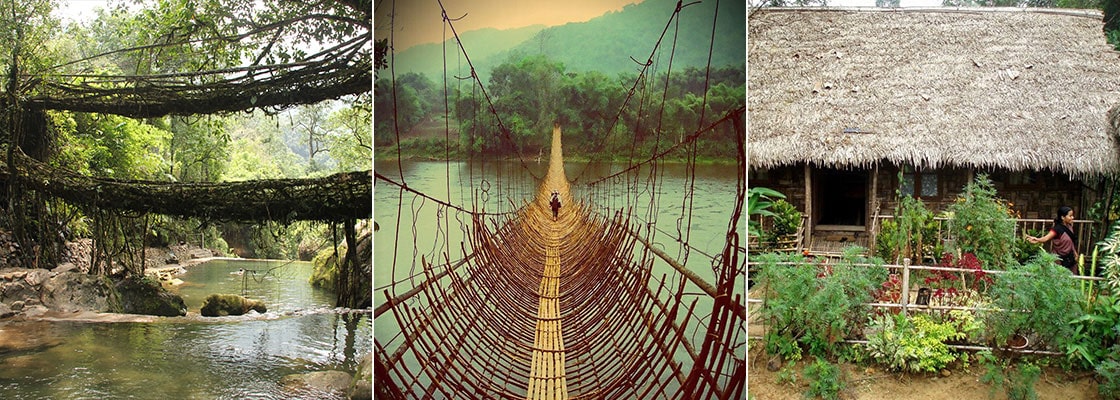
Not all Kings (or Queens) built things ostentatious. Despite being home to one of the longest-running dynasties In India – the Ahom Dynasty of Assam – who ruled for nearly 600 years, Northeast India doesn’t have any stunning forts, and places. Architecture in Northeast India has always been about tradition, community, climate, and functionality – even for the royals who didn’t build anything grand that can be called an architectural marvel. The British who colonised the region at the beginning of the 19th century were quick to adopt the vernacular architecture of the region. The Chang Bungalows (Bungalows on stilts) that still dot the landscape of Assam, particularly the tea estates, for example, was an adaptation of tribal dwellings built keeping in mind the wet climate of Assam and the annual flooding during monsoon. Another example is the fast vanishing “Assam Type House” made with walls of bamboo or reed mesh (known locally as ikora) and plaster set in a wooden framework. They have a light tin roof and wooden floors that are highly earthquake resistant. It is worth mentioning here that the entire region of Northeast India is a highly earthquake-prone zone and has experienced devastating earthquakes in the past.
The robust vernacular architecture of Northeast India is one of India’s earliest examples of sustainable building designs.
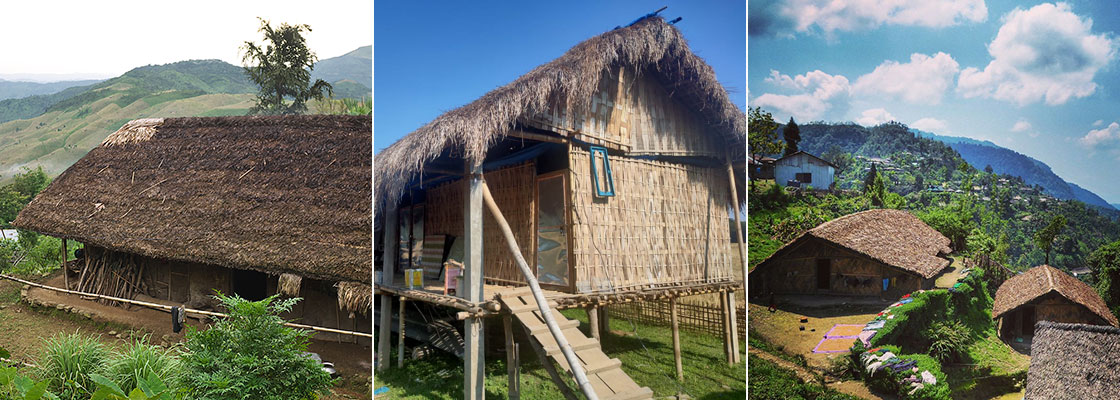
The region’s luxuriant flora is handy for constructing houses suitable for its climate, as well as for its geographical conditions. The varieties of bamboo that constitute the primary construction material for dwellings are almost uncountable. To these should be added the various kinds of cane, grasses, and palm leaves used to make joints and thatched roofs. Depending on its location – on a sloping hill, on the bank of a river, or at the foot of the Himalayas – each tribe possesses a distinct model for houses. Just like their textiles, their dwellings are also an assertion of identity.
In most of the tribes, they are not simply an assemblage of materials, but rather living bodies that age and catch diseases, the reason behind many tribes changing their foundations regularly. Houses, it is believed, also have souls and is the dwelling place of the ancestors. Many tribes believe that spirits can shift from an ancient style to a modern one. Whilst some tribes believe that they do not live in the house, but the house allows them to live by providing a gathering place to eat and to sleep, some of the dwellings made with materials meant to last for more than a hundred years are big enough to accommodate a hundred people. The exteriors of these fairly large houses are decorated with skulls of the buffalo and until recently human skulls, given the region’s headhunting tradition, particularly among the Naga Tribes of Nagaland and Arunachal Pradesh. In the Buddhist part of Northeast India, particularly Sikkim and Arunachal Pradesh the centuries-old monasteries were constructed without any drawings or architectural plans but with spiritual inspiration from the Head Monk. The “Namghor” (community prayer hall) of Assam is a melange of architectural elements borrowed from the different local tribes and even Southeast Asia, the original home of the Ahom Kings who used fish oil, duck eggs, and sticky rice as building materials.
Northeast India’s vernacular architecture is also a lesson on community. The bamboo and cane suspension bridges over the rivers of Arunachal Pradesh are fantastic examples of the community coming together and building it with their bare hands using bare basic tools. Even now it is a practice among many tribes where relatives travel long distances to help their family members build a new house where the community also pitches in.
But the most fascinating part of Northeast India’s vernacular architecture is man and nature co-existing in harmony. The Living Roots Bridges of Meghalaya is a fine example of this symbiotic relationship. The bamboo bridges built to cross streams and rivers in Meghalaya couldn’t bear the brunt of the heavy monsoons. They would rot and break, leaving the people stranded. So the locals devised a clever method. They built suspension bridges made by shaping the living roots of rubber trees that were native to Meghalaya. It took 15 to 20 years for a surreal, strong web of tangled root bridge to connect two banks which grew extraordinarily sturdy with each passing year and lasted for centuries.
Explore
Nashik – A perfect mix of traditional and modern
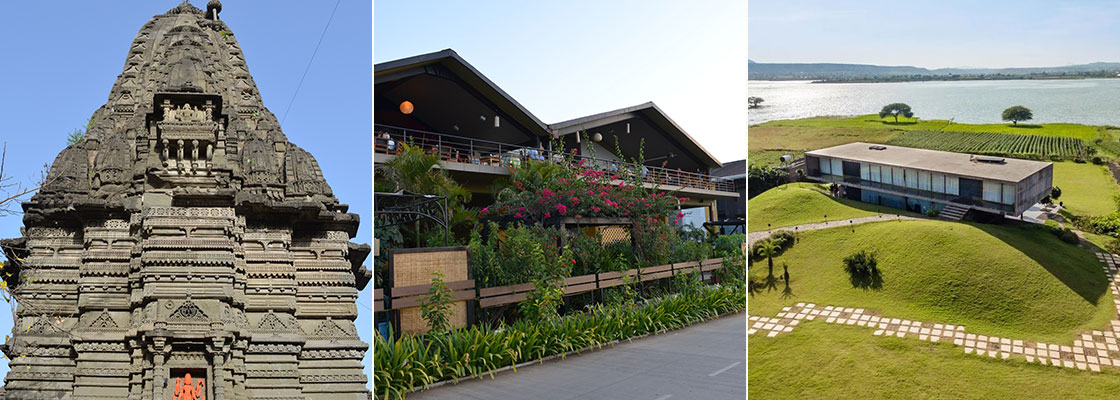
Located four and a half hours northeast of Mumbai on the banks of the River Godavari, Nashik has a dual identity that most people find baffling! On one hand, it is a spiritual city with more than a hundred ancient temples playing host to the famous Kumbh Mela every 12 years and on the other, it is designated as the ‘Wine Capital of India’ due to the Sula Vineyard, the first successful vineyard of India located on its outskirts! The city does well in weaving its traditional roots with its aspirations of modernity.
Best time to visit
The best months to visit are from October to March before the heat kicks in. Nashik experiences moderate rainfall in the months of June which lasts till September.
Fairs and Festivals
Kumbh Mela: The most important Hindu spiritual gathering in India that happens once every three years, rotating between the four major Hindu pilgrim centres – Prayagraj, Haridwar, Ujjain, and Nashik. The next Kumbh Mela is scheduled to be held in Nashik in the year 2027. Kumbh Mela in Nashik is a mammoth affair attended by nearly three and a half million pilgrims.
Ram Rath Yatra: A major during the Ram Navami festival which is held sometime in the second week of March. The grand celebrations are held at the Kalaram Mandir at Panchavati, Nashik.
Sites to visit in and around Nashik
We recommend one night in Nashik to explore the old town and its temples and one night at the Sula Vineyards
While in Nashik, go for a walk around the Panchavati–Ramkund area in the old town which has several temples located on the banks of River Godavari. Some of the temples to visit here are
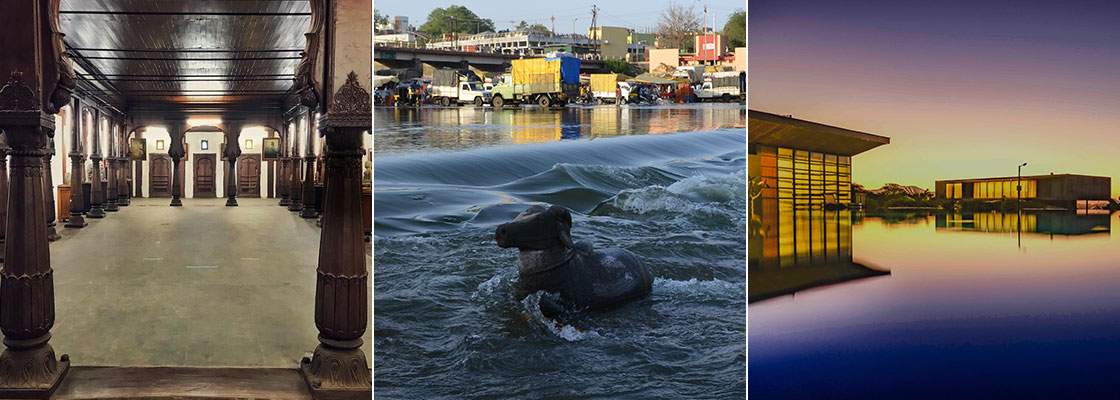
Sundar Narayan Temple, Naroshankar Temple, and Kalaram Temple. Exploring this area will give you an understanding of how religion supports the livelihoods of the locals. The many beautifully decorated shops near the temples sell things that are frequently bought by the pilgrims entering the temples for worship. During the walk visit an interesting heritage building called the ‘Sarkarwada”. This 18th-century mansion was once the seat of the Peshwas – the erstwhile rulers of the city and still retains its grandness with its unique wooden carved courtyards, distinct carvings on outside walls, and decorated windows. It is now a Museum open to the general public. If you happen to visit the area on a Wednesday, you will be treated to lively scenes of a colourful ‘Haat’ (flea market) that takes place on the banks of river Godavari. The market caters to the needs of the people living in and around Nashik selling handmade iron utensils, clay pots, and farm tools, spices, dried fish, clothes, colourful carry-bags, and silverware.
Next day, proceed to the Sula Vineyards located 15 km northwest of the city for an overnight stay at one of their Resorts – ‘Beyond Sula’ or ‘The Source at Sula’. This would be a day of wine, food, and scenic views. Walking through a bustling winery, watching Sula installations closely, and understanding the process of wine making from grape to glass is a part of the Sula experience.
Handicrafts and arts
The markets of Nashik are renowned for their gorgeous jewellery, art and craft, and handloom items like Bidriware, Kolhapuri Chappals (sandals), Kolhapur Jewellery, Mushroo and Himroo textiles, Paithani Saris and Warli Paintings.
Stays we recommend
The Taj Gateway Hotel Ambad, Nashik: Surrounded by 20 acres of lush, landscaped gardens, The Taj Gateway Hotel Ambad is the most preferred choice of stay among both business and leisure travellers.
https://www.tajhotels.com/en-in/taj/ambad-nashik/
Beyond By Sula: Tucked behind the rolling hills of Gangapur and surrounded by the serenity of its calm waters, Beyond by Sula has 10 luxurious rooms. This elegantly designed abode offers 7 Executive Rooms and a 3-bedroom villa. All rooms overlook the lake and the Nashik countryside and come fully stocked with the finest wines from the House of Sula.
https://sulavineyards.com/stay-with-us.php
Accessibility
Nashik is best accessed from Mumbai by road (National Highway 160). It is also connected by road to other nearby cities such as Pune, Aurangabad, and Surat.
Nashik Airport is located 20 km outside the city with non-stop flights to Delhi, Ahmedabad, Hyderabad, Pune, and Belgaum.
Nashik lies on the main railway routes from Bhopal to Mumbai, Varanasi to Mumbai, Kolkata to Mumbai, and Bhubaneswar to Mumbai. Some of the premium trains like the Rajdhani Express and Duronto Express stop at Nashik Road Railway Station.
Festivals to look out for
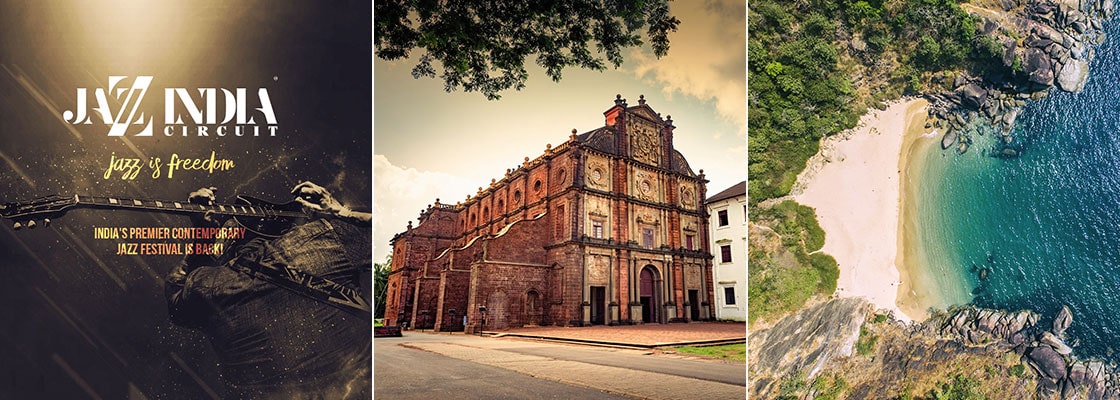
Jazz it up at the Jazz India Circuit, Goa from 25th to 26th February 2023
Since its beginnings in New Orleans in the late 19th century, Jazz music has evolved and spread around the world with new styles. If you are a Jazz fan then head to Goa in February 2023 for a good reason – Teamwork Arts’ Jazz India Circuit will be live featuring some old-world as well as newer forms of experimental jazz music.
Just as it has done in the past, the festival brings the best of Jazz to Goa. But there’s more! The Jazz India Circuit will be a potpourri of exhilarating experiences such as music workshops, interactive experiential spaces, a bustling flea market, a vibrant food court of global cuisine, a feast of art and craft activities, and a whole lot more. From world-renowned artists to local Jazz talent, Jazz India Circuit 2023 will be an incredible celebration of life, music, and freedom. Kicking off on February 25, 2023, we strongly recommend that you start making those vacation plans to Goa as soon as possible.
For more details, please write to us.
RESOURCES
SITE LINKS
CONTACT US
+ 91 (124) 4563000
Tower B, Delta Square, M.G. Road, Sector 25, Gurgaon - 122001, Haryana, National Capital Region of Delhi, India


